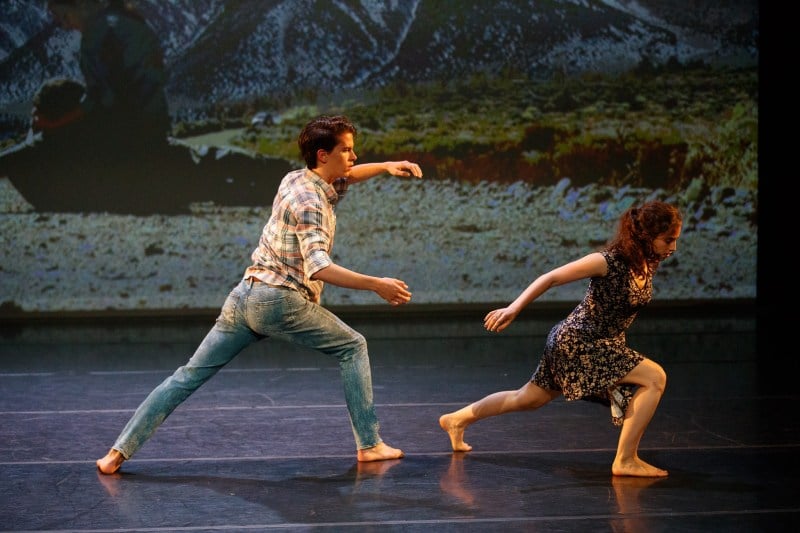The art of storytelling can take many forms, whether it be through dance, film or the written and spoken word. Stanford Theater and Performance Studies, in their multimedia production of “No Hero,” incorporates all of these art forms to develop a comprehensive, oft-unheard narrative about the meaning of dance in the rural west. The production showcases the talent and expertise of TAPS’ elite contemporary dancers alongside live footage, which details renowned choreographer and Stanford faculty member, Alex Ketley, and his tour of Western rural America in 2012.
The performance space, the Roble Arts Dance Studio, provides an intimate setting which is perfectly conducive for the intimate storytelling experience. The stage, a flat black square bordered by two benches on two sides, is rather simplistic — and rightfully so, as the stories themselves take precedence over the space.
It is ambitious, perhaps brave, to integrate such diverse artistic mediums in a single production, but the risk is well worth the result. “No Hero” is a bold production that investigates the lives of ordinary citizens in the Western states and translates their distinct stories into a cohesive, extraordinary work about love, loss, community and identity.
Combining live dance performance and documentary film, “No Hero” shares these Western narratives in a visceral, affecting manner. One documentary scene tells — via video, pictures and written words — the story of a man named Ara who began traveling with his dog, Spirit, after the loss of his son, Lance. At the same time, a live dancer emerges center stage under a bright yellow spotlight, falling to the ground in one moment and then rising again, much like a spirit. The rise and fall of her movements provides a visually powerful representation of Ara’s real-life emotional struggles — the ups and downs of his new life without a son. There is a sense of loneliness, of wandering, of searching for meaning as the projection shifts to Ara and his dog driving along an empty road; the live dancer, meanwhile, portrays this restlessness by angling her elbows and knees at 90 degree angles and mimicking a running motion of sorts. This moment is particularly moving, especially at the end of the story, when the stage goes completely dark.
In another scene, an interview with Warren and Linda — a rather honest and unassuming couple — of Lake Topaz details their experiences with the “uninhibited and fun” nature of dance among youth, particularly their grandchildren. As their dialogue cuts out, a video of a young woman in a desert-like landscape emerges. Sounds of rushing winds fill the performance space, and the film dancer appears to move against these winds. Just then, a live dancer appears before the screen, arms open in a sort of embrace of nature. As the projection shuts off, the live dancer moves with wide and sweeping gestures. She extends her arms and bends her knees in wild yet precise movements, echoing Warren and Linda’s earlier account of dancing as “uninhibited.”
In addition to the filmed and live-dance parts, the production is also joined by instances of verbal narratives. One such narrative resembles a spoken-word poetry piece with its commanding and rhythmic tonality. As the performer speaks, she dance, placing her hand over her chest, turning, kicking and pausing for a full-body narrative experience. The result is both visually stimulating and orally poetic.
In the final piece, black and white images of the rural interviewees inundate the screen as the live dancers freeze in stylized poses. The pictures — which display images of a lone man and a young couple, to highlight a few — transition faster and faster as the instrumental music crescendos. As the music reaches its peak, the screen shifts to an image of a rising yellow sun, shining above a mountainous horizon. The golden rays are reminiscent of the yellow lights used throughout the live show. This bright light engenders a rather hopeful tone, perhaps suggesting that art — in particular, dance — is a hopeful, unifying aspect within a community.
With a skillful conglomeration of live dance, dialogue and photo and video projections, TAPS’ “No Hero” renders itself a multimedia touchstone. The production stirs a deep appreciation for all art forms, both auditory and visual. In a way, the production itself is a dance, seamlessly weaving through live performance and recordings, much like carefully choreographed dance steps. The result is, in my opinion, deserving of a standing ovation. “No Hero” is unique, compelling and captivating.
Showtimes are May 25 – 27, at the Roble Gym dance studio, at 8:30 p.m.
Contact Alli Cruz at allicruz ‘at’ stanford.edu.
